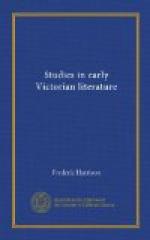“Coningsby, Sybil, and Tancred,” says he, in his grandiose way, “form a real Trilogy.” “The derivation and character of political parties,”—he goes on to explain—“was the subject of Coningsby.” “The condition of the people which had been the consequence of them”—was the subject of Sybil. “The duties of the Church as a main remedial agency” and “the race who had been the founders of Christianity” [although, surely, friend Benjamin, if we are to believe the Gospels, the murderers and persecutors of Christ and His Apostles]—were the subjects of Tancred (1847). Tancred, though it has some highly amusing scenes, may be dismissed at once. Disraeli fought for the Chosen Race, their endowments and achievements, with wonderful courage and ingenuity. It was perhaps the cause which he had most deeply at heart, from its intimate relation to his own superb ambition and pride. But it has made no real way, nor has it made any converts, unless we count Daniel Deronda as amongst them. Thackeray’s “Codlingsby” has almost extinguished “Sidonia.” And the strange phantasmagoria of the Anglican Church, revivified by the traditions of Judaism, and ascending to the throne of St. Peter, is perhaps the most stupendous joke which even Disraeli had ever dared to perpetrate. In the preface to Lothair we read:—
The tradition of the Anglican Church was powerful. Resting on the Church of Jerusalem, modified by the divine school of Galilee, it would have found that rock of truth which Providence, by the instrumentality of the Semitic race, had promised to St. Peter.
Whatever this jargon may mean, the public has allowed it to fall flat. It seems to suggest that the Archbishop of Canterbury, by resuming the tradition of Caiaphas, as “modified” by the Sermon on the Mount, might oust the Pope of Rome as was foretold by the Divine young Jewish reformer when he called the fishermen of Galilee. It is difficult to believe that Disraeli himself was serious in all this. In the last scene, as Tancred is proposing to the lovely Jewess, their privacy is disturbed by a crowd of retainers around the papa and mamma of the young heir. The last lines of Tancred are these:—“The Duke and Duchess of Bellamont had arrived at Jerusalem.” This is hardly the way in which to preach a New Gospel to a sceptical and pampered generation.
But, if the regeneration of the Church of England by a re-Judaising process and by return to the Targum of the Pharisees has proved abortive, it must be admitted that, from the political point of view, the conception announced in the “trilogy,” and rhapsodically illustrated in Tancred—the conception of the Anglican Church reviving its political ascendancy and developing “the most efficient means of the renovation of the national spirit”—has not proved quite abortive. It shows astonishing prescience to have seen fifty years ago that the Church




